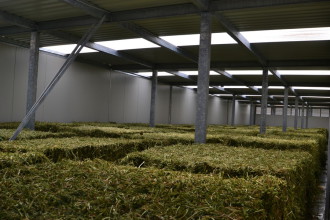
2024 - 54 YEARS OF PASSION AND EXPERTISE!
HAY DRYERS COMPACT: FREQUENTLY ASKED QUESTIONS BY THE CUSTOMERS OF AGRICOMPACT HAYDRYERS
WHICH COMPACT HAY DRYER DO YOU OFFER FOR DRYING HAY BALES?
Our offer consists of 2 types of COMPACT Hay Dyers for round and square bales:
- Compact Hay Dryers in metallic construction
- Compact Hay Dryers in concrete construction.
Both techniques EXCLUSIVELY use the heat recovery with air recirculation where the passage of air is STRICTLY from the bottom to the top of the hay bale.
Our unique drying technique has been on the market since 1990 and has been sold to over 500 customers in eight European countries and North America
WHICH TYPE OF COMPACT HAY DRYER DO YOU RECOMMEND?
The COMPACT Hay Dryers in metallic construction are quickly assembled. They have to be placed on a concrete floor. The COMPACT Hay Dryer is designed as an optimized system for all processes: loading, unloading and drying. In this way you can dry both round and square bales without any problem. The grid is not suitable to ride on it with tractors/telescopics although it is robust and designed to bear the weight of 2 stacked hay bales.
On request it will be possible to equip the COMPACT Hay Dryer with an even more robust grid adequate to support metal containers suitable for the drying of e. g. corn etc.
For those customers who would like to adapt their already existing shed etc. or those who would like to build a new shed etc. (in wood, concrete, steel, greenhouse etc.), we can design a COMPACT Hay Dryer in concrete construction. In these cases the customer has to build the grid for the round or square bales, the platform for the drying zone, provide and install the sliding doors, close and insulate the walls of the shed in order to maintain the heat inside of the structure best possible.
You can ride with your tractors/telescopics on the grid.
Please, note: You have to make a choice at the very beginning of your drying project whether you would like to dry round bales or square bales when using a COMPACT Hay Dryer in concrete construction.
WHAT IS THE DIFFERENCE BETWEEN THE HAY DRYER COMPACT IN METALLIC CONSTRUCTION VERSUS CONCRETE CONSTRUCTION?
We offer 2 products:
(1) our turn-key solution in metallic (steel) construction
(2) our composite solution in concrete construction
Each solution offers flexibility to our customers and is designed to fit your drying needs. Both solutions offer a standard drying engine, which is manufactured in steel. When we refer to metallic (steel) vs. concrete, we are talking about the drying zone where the bales will be physically dried. Regardless of your selection, you will receive guidance and construction planning throughout the project.
|
|
Turn Key Solution Metallic (Steel) |
Composite Solution Concrete |
|
Material used for drying engine (fan, motor, control panel) |
Steel |
Steel |
|
Material used for drying zone |
Steel |
Concrete/Wood/Steel |
|
Customer construction requirements |
- Concrete Base - Electrical Source (Propane/Gas/Diesel)
|
- Concrete Base - Drying Zone - Shelter including airflow ducts and insulation - Electrical Source (Propane/Gas/Diesel) |
|
Electrical options |
- Standard: Start-Delta-Starter - Optional: Full Variable Speed Drive
|
- Standard: Start-Delta-Starter - Optional: Full Variable Speed Drive
|
|
Number of bales dried at same time |
48
|
50*
|
|
Type of bale (round vs. square) |
Round or square in any combination |
Either all round or all square* |
|
Maximum bale weight |
1,100 lbs |
1,100 lbs |
|
Maximum humidity of bale at time of baling |
30 - 35%** |
40 – 45%** |
|
Multi-use drying zone? |
No |
Yes – the drying zone can be reused to store heavy farm equipment, dried forage etc. |
|
Optional Cooling Zone |
- Steel fan and control panel - Customer constructs a shelter in material of choice* |
- Steel fan and control panel - Customer constructs a shelter in material of choice* |
|
Shipping requirements for one Hay Dryer COMPACT |
We ship approx. 5 containers (HC 40’’) to port of entry |
We ship 2 containers (HC 40’’) to port of entry |
|
Training |
On site training for technical system use and best practices for optimal results |
On site training for technical system use and best practices for optimal results |
* We can customize a solution on request
** Variable depending on your regional climatic conditions and type of forage
WHAT ARE THE DIFFERENT SIZES OF THE COMPACT HAY DRYERS?
Regarding the COMPACT Hay Dryer models built in metallic construction, there are 2 options:
4 rows and 3 rows.
The plants with 4 rows for drying round/square hay bales are equipped with sliding doors on both sides of the drying zone in order to easily load and unload with your telescopics from both sides.
The COMPACT Hay Dryer models are designed to dry a preset number of hay bales with a range of:
24 - 32 - 40 - 48 - 56.
On request it will be possible to design a COMPACT Hay Dryer for the drying of 16 bales.
The plants with 3 rows for drying round/square hay bales are equipped with sliding doors on one side of the drying zone in order to load and unload with your telescopics from one side.
The COMPACT Hay Dryer models are designed to dry a preset number of hay bales with a range of:
18 -24 – 30 – 36 – 42 - 48.
On request it will be possible to design a COMPACT Hay Dryer for the drying of 12 bales.
Regarding the COMPACT Hay Dryer models built in concrete construction have the following parameters:
- for round hay bales a minimum of 16 to a maximum of 56
- for square hay bales a maximum of 110.
For a more detailed information about our COMPACT Hay Dryers in metallic construction, we recommend visiting the category COMPACT HAY DRYERS IN METALLIC CONSTRUCTION.
For a more detailed information about our COMPACT Hay Dryers in concrete construction, we recommend visiting the category COMPACT HAY DRYERS IN CONCRETE CONSTRUCION.
HOW DO I CHOOSE BETWEEN THE HAY DRYER COMPACT IN METALLIC OR CONCRETE CONSTRUCTION?
The relative moisture of the bales at the time of baling is the most important factor to help you make your decision. This is, of course, a function of your local climatic conditions. Our hay dryers are optimized to dry your hay with maximum moisture between 30 - 35% down to the desired moisture level, with a maximum weight of 1,100 lbs. If you anticipate higher moisture in your bales at the time of baling, then the collaborative solution in concrete is the best option for you.
A second consideration is the desire to have a multi-use structure. Some of our customers prefer the collaborative solution in concrete because the concrete drying zone can be repurposed to store heavy farm equipment in the off season. The concrete drying zone can also double as your winter shed, where you can store your dried bales until you are ready to use them.
If you chose the composite solution in concrete, our technical expert will provide you with the plans and specifications to complete the necessary construction and will provide guidance throughout the process.
If you want to minimize your responsibility for local construction, and you have acceptable moisture consideration in your bales (between 30 - 35% ), then the elegant turn-key solution in metallic (steel) construction could be an excellent option for you. In this case we furnish both the Technical Unit (drying engine) and the Drying Zone to you. Keep in mind that you will still need to provide the concrete base upon which the Hay Dryer COMPACT will be installed.
I LIVE IN A WARM, DRY CLIMATE AND I USUALLY DRY MY BALES IN THE SUN. HOW WOULD THE HAY DRYER COMPACT BENEFIT ME?
In warm climates, you can anticipate the baling. This means that you get the hay away from the field earlier than usual and out of the burning sun, which preserves the color and nutrition. When a hay farmer uses solar radiation, it is more difficult to control the level of radiation and the hay can become yellow from oxidation. In the case of alfalfa leaves, avoiding direct sun radiation will preserve the delicate leaves, which are the true source of nutrition.
Regardless of your crop, our approach keeps your drying costs negligible because we exploit the low humidity of the ambient air, while avoiding the harshness of solar radiation.
I LIVE IN A WET, HUMID CLIMATE. DO I NEED A COOLING ZONE?
The demands of a humid climate require some form of automation in order to achieve the desired moisture of your crop and preserve your investment. The Hay Dryer COMPACT is ideal for humid climates especially when combined with our Cooling Zone. Fundamental to every hay drying solution is the Drying Zone, which typically dries 48 bales at a time. While those bales are drying, you need to protect the bales that are waiting to be dried. We have introduced the concept of a Cooling Zone, which is used to store your cut bales while they are waiting to be dried. The Cooling Zone takes the bales out of the field and prevents fermentation in the bales.
For example, let’s say you perform a cut resulting in 150 bales. Immediately, 48 bales will go into the Drying Zone of your Hay Dryer COMPACT and the remaining 102 bales would go into the nearby Cooling Zone. In this way, all bales are removed from the moisture and are in the process of drying (48 bales drying under regulated heat in the Drying Zone/102 bales under ventilated air drying in the Cooling Zone). Once the first batch of 48 bales has been dried to your satisfaction, then the next 48 bales resident in the Cooling Zone will go into the Drying Zone. The remaining 54 hay bales still stay in the Cooling Zone without fermenting because they are being ventilated away from the moisture. Note: In your Cooling Zone you can stack your hay bales to double your capacity, e.g. a Cooling Zone of 48 bales can hold 96 hay bales (double stacked).
I TYPICALLY WORK WITH HAY BALES THAT EXCEED 1.100 lbs. IS THE HAY DRYER COMPACT THE RIGHT SOLUTION FOR ME?
Hay bales in excess of 1,100 lbs and with moisture between 30 – 35% have a mass that is much too high to permit the flow of dry air. Consequently, the hay does not dry properly and the risk of micro-fermentation and/or mold from wet spots can ruin your hay. Our Hay Dryer COMPACT is designed to produce nutritious, green, high quality hay. Therefore, for customers who deal in bulk volume, we propose the following solution:
Customers would deconstruct their large bales into bales no heavier than 1,100 lbs and dry their product according to AgriCompact specifications. Once the hay has been properly dried, then the customer can rebale the hay into any size. There are companies specialized in hay compression which offer a baling machine that can be purchased separately to support this solution
Alternatively, there is a different market solution, which uses a process called dehydration. AgriCompact Technologies GmbH does not support this solution because it does not align with our requirement to produce the freshest, nutrient-rich hay. Clients who wish to consider this option would need to make a capital investment in a dehydration machine and would then dry their hay in lose batches (rather than in bales) under very high heat. The upside is you can process a large volume of hay using this method. The downsides are the high cost of the dehydration machine and the inferior quality of the final product.
WHAT ARE THE DIFFERENT SIZES OF THE HAY BALES THAT CAN BE DRIED?
The standard sizes to which we have adapted our COMPACT Hay Dryer are as follows:
- square bales approx. 210 cm x 120 cm x H 90 cm
- square bales approx. 210 cm x 120 cm x H 70 cm
- square bales approx. 210 cm x 120 cm x H 60 cm
- round bales with variable chamber/variable geometry or fixed chamber:
diameter 150 cm to 180 cm x H 120 cm
On request it will be possible to dry other sizes as well.
WHAT DOES THE TECHNIQUE OF HEAT RECOVERY USING AIR RECIRCULATION MEAN?
Many customers asked us why we use the technique of heat recovery with air recirculation.The answer is quite simple as well as intuitive: This unique technique has been studied and applied by our family since 1990 and it allows us to dry the forage regardless of weather conditions focussing the factors quality and drying costs. So we equipped our COMPACT Hay Dryer with a software which manages an "intelligent" use of air available both in the COMPACT Hay Dryer as well as outside. The whole drying system is automated and it decides how - if - when to use the air from outside or the air coming from the drying zone (where the hay bales are in).
This technique makes us unique in the market and makes it possible to dry forage even in those areas of the world that are particularly disadvantaged in terms of weather: Northern Europe, mountain regions (e. g. the Alps, Appenine, Pyrenean regions), territories with a continental climate and strong thermal excursion during 24 hours, zones with a a lot of humidity.
WHY DO YOU EXCLUSIVELY DRY BOTTOM-UP?
Our family has been pioneer in the drying of hay bales since the 1980's using various drying techniques to optimize the timing and the drying costs. After several years of research and testing we have arrived at these conclusions:
- With a single air-flow you can dry square bales and round bales which are heavier.
- We exploit a natural concept: the hot and moist air is lighter than the cold and dry air. The light and hot/moist air passing through a hay
bale always goes up. This avoids the ponding of moisture in the hay bale. In extreme cases (e.g. rain, storm etc.) we can load the drying zone of our COMPACT Hay Dryer with 2 stacked hay bales. This makes the drying process faster for the hay bale which is ground-level and keeps the upper hay bale cool and
therefore excludes fermentation. Our technicians will explain the process in detail to you.
Q WHAT DO I HAVE TO DO ONCE THE HAY BALES HAVE BEEN DRIED WITH THE COMPACT HAY DRYER?
We advise our customers to dry the forage until a final bale moisture of or inferior to 13%. Here come the advantages:
- You can immediately store the hay bales in your warehouse. There is no risk of fermentation.
- You can feed the forage immediately to your animals (milk-cows, goats, sheep, horses etc.)
A very intersting fact is that if you would like to sell the hay bales immediately after drying, you could sell the dried product immediately because you would not have to wait 40 - 60 days in terms of maturation.
HOW CAN I DETERMINE THE MOISTURE CONTENT OF THE HAY BALES BEFORE AND AFTER DRYING?
We recommend the use of an ELECTRONIC TESTER (HAY PROBE) measuring two values:
- moisture control of the forage on a scale from 0 to 100
- temperature control of the forage.
If you wish to learn more about it, please, go to the category HAY PROBE or CONTACT US.
WHY DOES THE FORAGE DRIED WITH A COMPACT HAY DRYER HAVE SUCH A GOOD SCENT AND NOT THE TYPICAL SMELL OF DEHYDRATED FORAGE?
We recommend to our customers to come and see our COMPACT Hay Dryers personally in order to experience the scent and quality of the forage in person. The difference to other hay drying results will be all evident to you then.
TO DRY HAY BALES WITH A HAY DRYER: IS IT ENOUGH TO PRESS A BUTTON?
Generally spoken: It is not. This is an urban legend which has to be dispelled.
Excellent drying results in general are gained by investing in an excellent hay dryer but is is also necessary to work well already on the fields when cutting, swathing, baling etc. Further more, the customers have to be technically well trained. Once all these requirements are met, it will be possible to press the right button at our COMPACT Hay Dryer.
WHERE DO YOU THINK YOU ARE ONE STEP AHEAD WITH THE COMPACT HAY DRYER?
Regarding the challenging climatic conditions, the drying costs, the conservation of flavours and scent.
Another step ahead: Drying of medicinal and aromatic herbs and other products that have to maintain an excellent quality after having been dried.
If you wish to get to know more details about drying herbs, please, go to the category COMPACT HAY DRYERS FOR HERBS.
DO YOUR COMPACT HAY DRYERS ONLY DRY HAY BALES?
Our credo is: Satisfy the customers! This means that we design a COMPACT Hay Dryer tailored to the customer's needs. A lot of customers would like to dry apart from hay/hay bales products like cereals and a myriad of other products as well. Having started the drying business in 1970, the Tonelli family has got a vast experience in drying medicinal and aromatic herbs, seeds of ryegrass, seeds of onion, nuts, hazel nuts, apricot kernels, peanuts, corn grain, corn cobs , cotton seeds, tomato skin, orange peels, chilly peppers, wood chips, wine grapes etc. Our drying technique is unique and universal: Ask us for a drying concept and we will design it for you to your entire satisfaction - CONTACT US!
WHY CHOOSE A HAY DRYER FOR DRYING BALES INSTEAD OF DRYING LOOSE HAY?
My father began designing hay dryers for the drying of loose hay in the early 70s.
This technique was excellent for both using pneumatic distributors of forage as well as after a time the newer "Kran" (crane). In terms of quality the forage was great but nowadays we hardly use this technique any more because we do prefer the technique for drying hay bales explaining the reasons as follows:
COSTS: For designing an adequately big hay dryer for the drying of loose hay it occurred a high investment, e. g. storing 1,200 tons of loose forage the customer needed a drying zone of approx. 100 m x 20 m x 10 m H. The energy consumption was very high and much depending on the weather conditions. The whole process of loading/unloading required a lot of manpower. For a satisfying daily productivity the customer needed to have many forage harvesters and on a rainy day the hay dryer for loose hay had to remain always switched on although the customer could not upload new product because the forage harvesters could not upload any new product in the rain.
- - WEIGHT: The weight of the dried loose hay is very low. It is 60 to 100 kg/m3. A daily productivity of 50 tons of dried loose hay would be very difficult to achieve maybe even impossible.
However we recommend the technique of drying loose hay for small mountain farms with a barn above the stable and with a small daily productivity.
IS IT POSSIBLE TO APPLY THE COMPACT HAY DRYERS TO A BIOGAS PLANT?
We customized several COMPACT Hay Dryers for round/square bales using the hot water from cogeneration. The application of thermal energy always depends on the size of the BIOGAS plant but avoiding any possible problem e.g. that thermal energy is not available for a reason or is simply insufficient when needed, we equip our COMPACT Hay Dryers with a combustion chamber of adequate power.
Apart from the BIOGAS plant we customized COMPACT Hay Dryers for round/square bales for the use of hot water from geothermal application.
These applications are excellent regarding the very low drying costs.
DOES TECHNOLOGY AND RESPECT FOR THE ENVIRONMENT GO HAND IN HAND?
Yes, thanks to technology we can be more attentive to the respect of the environment. We are convinced that we can reach a high quality standard using the most natural, non-aggressive techniques, e.g. avoiding the excessive use of heat from mineral fuels and fossils. To simplify our concept, our challenge is to provide the market with advanced technologies to ensure that our customers have the best possible outcome: make the best hay possible with a cost as low as possible. This is a business philosophy which avoids the "everything! - at once!".
Hence our credo: "Wir leben Natur!" ("We live nature!")
CAN YOU MEET ALL CUSTOMERS' REQUIREMENTS?
Yes, we can! This is one of our company's strength: we design our COMPACT Hay Dryers to the complete satisfaction of each customer because our COMPACT Hay Dryers are tailored to the customer's needs. For the sake of the customers we pick them up where they are and accompany them safely and reliably through the complete drying project into the world of COMPACT Hay drying. CONTACT US!
DOES THE PERFECT HAY DRYER EXIST?
No, it does not. Nobody has got the magic wand! This is the reason why we are in a continuous process of research and development to perfect our techniques. Thanks to 43 years of drying experience we can provide you with these advanced and appropriate techniques in harmony with a fruitful teamwork with our customers.
WHY DOES THE MARKET THINK YOU ARE ONE STEP AHEAD WITH THE DRYING OF HAY BALES?
Our family has more than 30 years of experience in drying hay bales and we consider ourselves pioneers in this field. Further more we have been drying loose hay since the 70's. These are facts of which we think the customers are searching for on the market. Nobody is willing to invest important sums of money for entering in an adventure of interesting but theoretical techniques.
WHEN IS IT ADVISABLE TO BUY A HAY DRYER FOR THE DRYING OF HAY BALES?
From a total annual production minimum of 100 tons of hay (approx. 250 hay bales).
IF A CUSTOMER HAD AN OLD HAY DRYER FOR BALES, WHAT WOULD YOU RECOMMEND HIM TO DO?
In this case we recommend to modernize their old hay dryer with the advantage of then possessing a more technological and efficient one. Modernizing means e.g. replacing the fan and the heat generator with a modern COMPACT Hay Dryer and adapting the drying zone according to the instructions of our technicians.
WHAT ARE YOUR PLANS FOR THE FUTURE?
We are studying state of the art and innovative applications which for now are secret!
@david_vacy hi David, nope, cuz our clients are our trade fair! Much better insights + personal exchange with Farmers hands on
— AgriCompact Germany (@haydryers) May 19, 2014
@david_vacy see, a lot of our clients are in Northern Italy (because of artisan cheese produce)
— AgriCompact Germany (@haydryers) May 19, 2014


















